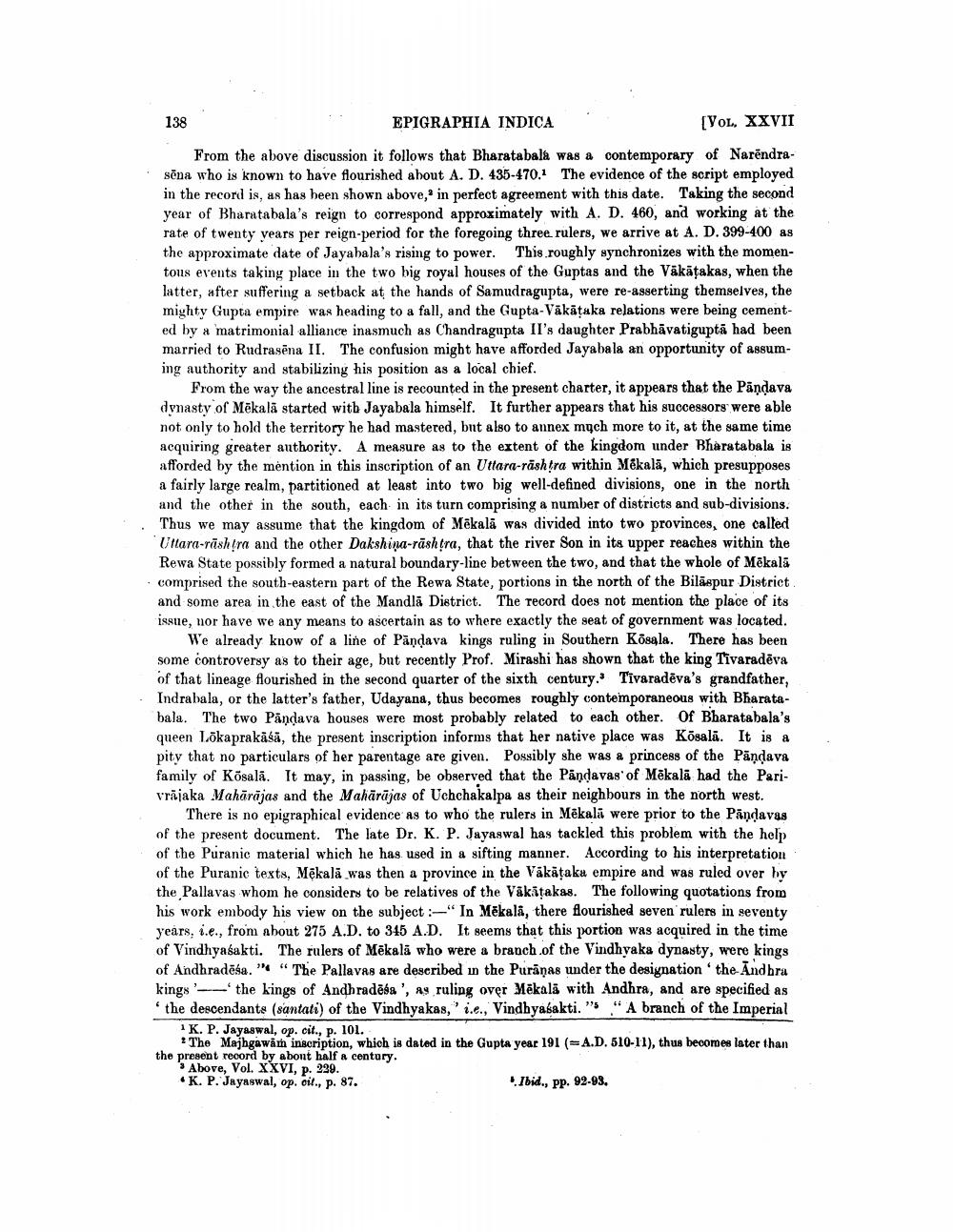________________
138
EPIGRAPHIA INDICA
.
[Vol. XXVII
From the above discussion it follows that Bharatabala was a contemporary of Narēndrasēna who is known to have flourished about A. D. 435-470.1 The evidence of the script employed in the record is, as has been shown above, in perfect agreement with this date. Taking the second year of Bharatabala's reign to correspond approximately with A. D. 460, and working at the rate of twenty years per reign-period for the foregoing three rulers, we arrive at A. D. 399-400 as the approximate date of Jayabala's rising to power. This roughly synchronizes with the momentous events taking place in the two big royal houses of the Guptas and the Väkātakas, when the latter, after suffering a setback at the hands of Samudragupta, were re-asserting themselves, the mighty Gupta empire was heading to a fall, and the Gupta-Vākātaka relations were being cemented by a matrimonial alliance inasmuch as Chandragupta II's daughter Prabhāvatiguptā had been married to Rudrasēna II. The confusion might have afforded Jayabala an opportunity of assuming authority and stabilizing his position as a local chief.
From the way the ancestral line is recounted in the present charter, it appears that the Pandava dynasty of Mēkalā started with Jayabala himself. It further appears that his successors were able not only to hold the territory he had mastered, but also to annex much more to it, at the same time acquiring greater authority. A measure as to the extent of the kingdom under Bharatabala is afforded by the mention in this inscription of an Uttara-rāshtra within Mékalā, which presupposes a fairly large realm, partitioned at least into two big well-defined divisions, one in the north
and the other in the south, each in its turn comprising a number of districts and sub-divisions. . Thus we may assume that the kingdom of Mēkalā was divided into two provinces, one called
Ullara-rāshtra and the other Dakshina-rāshtra, that the river Son in its upper reaches within the
Rewa State possibly formed a natural boundary-line between the two, and that the whole of Mēkalā • comprised the south-eastern part of the Rewa State, portions in the north of the Bilaspur District
and some area in the east of the Mandla District. The record does not mention the place of its issue, nor have we any means to ascertain as to where exactly the seat of government was located.
We already know of a line of Pandava kings ruling in Southern Kosala. There has been some controversy as to their age, but recently Prof. Mirashi has shown that the king Tivaradēva of that lineage flourished in the second quarter of the sixth century. Tīvaradēva's grandfather, Indrabala, or the latter's father, Udayana, thus becomes roughly contemporaneous with Bharatabala. The two Pandava houses were most probably related to each other. Of Bharatabala's queen Lokaprakāśā, the present inscription informs that her native place was Kösalā. It is a pity that no particulars of her parentage are given. Possibly she was a princess of the Pandava family of Kõsalā. It may, in passing, be observed that the Pandavas' of Mēkalā had the Parivrājaka Mahārājas and the Mahārājas of Uchchakalpa as their neighbours in the north west.
There is no epigraphical evidence as to who the rulers in Mēkala were prior to the Pandavas of the present document. The late Dr. K. P. Jayaswal has tackled this problem with the help of the Puranic material which he has used in a sifting manner. According to his interpretation of the Puranic texts, Mēkalā was then a province in the Vákātaka empire and was ruled over hy the Pallavas whom he considers to be relatives of the Vākāțakas. The following quotations from his work embody his view on the subject :-"In Mēkalā, there flourished seven rulers in seventy years, i.e., from about 275 A.D. to 315 A.D. It seems that this portion was acquired in the time of Vindhyasakti. The rulers of Mēkalā who were a branch of the Vindhyaka dynasty, were kings of Andhradēša." "The Pallavas are described in the Puranas under the designation' the Andhra kings '--the kings of Andhradēša', ag ruling over Mēkala with Andhra, and are specified as the descendants (santati) of the Vindhyakas, i.e., Vindhyasakti." "A branch of the Imperial
1 K. P. Jayaswal, op. cit., p. 101.
* The Majhgawām inscription, which is dated in the Gupta year 191 (=A.D. 510-11), thus becomes later than the present record by about half a century.
Above, Vol. XXVI, p. 229. .K. P. Jayaswal, op. cit., p. 87.
Ibid., pp. 92-93.




